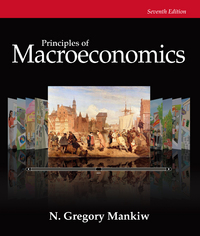Question
1. Consider an economy with the following characteristics: Consumption function is C = 100 + 0.8YD; Planned investment: I = 50; Government expenditure: G =
1. Consider an economy with the following characteristics: Consumption function is C = 100 + 0.8YD; Planned investment: I = 50; Government expenditure: G = 60; The tax function: T = 0.3Y; Exports of the country: X = 20 The import function: M = 10 + 0.06Y. Assume there are no transfer payments and no autonomous taxes. All variables are in billions of dollars. C is consumption expenditure; YD is disposable income; Y is real GDP; G is government purchases of goods and services; T is taxes; I is planned investment expenditure; X is exports, and M is imports. a. Write the aggregate expenditure function and find out the value of equilibrium level of income of the economy (3 marks) b. What is the value of consumption expenditure of the economy? (2 marks) c. Define the concept of multiplier. Calculate the size of the multiplier of the economy if government expenditure rises from $60 billion to $100 billion. Does the open economy multiplier is bigger than closed economy multiplier?
2. Gross fixed capital formation (GFCF) (investment) one of the most volatile components of GDP. In a diagram, show the movement of private and public GFCF of Australia over 2005 and 2024. Explain why GFCF is an important contributor to an economy.
Step by Step Solution
There are 3 Steps involved in it
Step: 1

Get Instant Access to Expert-Tailored Solutions
See step-by-step solutions with expert insights and AI powered tools for academic success
Step: 2

Step: 3

Ace Your Homework with AI
Get the answers you need in no time with our AI-driven, step-by-step assistance
Get Started


